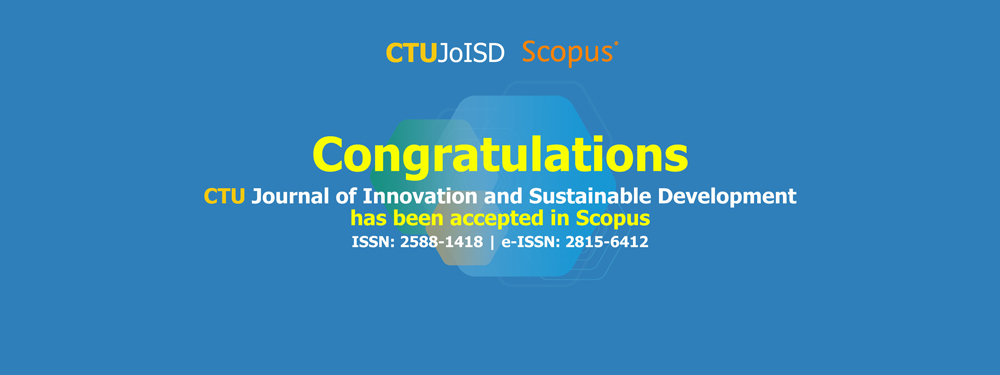CTU Journal of Innovation and Sustainable Development accepted into Scopus
CTU Journal of Innovation and Sustainable Development (CTUJoISD), ISSN 2588-1418 and e-ISSN 2815-6412, was officially accepted into the Scopus database on July 6th, 2025.

CTU Journal of Innovation and Sustainable Development (CTUJoISD), ISSN 2588-1418 and e-ISSN 2815-6412, is an international double-blind peer-reviewed journal that publishes original and high-quality research articles and review articles in multi-disciplines. It previously existed as Can Tho University Journal of Science (CTUJS) which was established in 2015 with assigned codes ISSN 2615-9422 and e-ISSN 2815-5602.
The aim of the Journal is to be a key source of research articles to provide scientific research results of Can Tho University in particular, and domestic and foreign scientific research projects in general, contributing to promoting scientific research and technology transfer.
The scopes of the Journal include, but not limited to, the following topic areas:
1. Agricultural and Biological Sciences;
2. Business, Management and Accounting;
3. Engineering;
4. Social Sciences;
5. Multidisciplinary.
Editor-in-Chief
Tran Ngoc Hai
Professor
Can Tho University, Viet Nam
Research Interests: Advances in Seed Production for Aquaculture, Advances in Aquaculture, Aquaculture Planning and Development, Integrated Coastal Zone Management
Deputy Editor-in-Chief
Tran Thanh Dien
PhD
Can Tho University, Viet Nam
Research Interests: Recommender Systems, Data mining in education
Editorial Board Members
Tetsu Ando
Professor
Tokyo University of Agriculture and Technology, Japan
Research Interests: Molecular Mechanism of Bio-Interaction
Fu-Sung Chiang
Professor
National Taiwan Ocean University, Taiwan
Research Interests: Consumer Economics, Fisheries/Aquaculture Economics, Demand and Market Analyses, Marketing and Trade
Nguyen Ngoc Dien
Associate Professor
Hoa Sen University, Viet Nam
Research Interests: Civil Law
Nigel K. Downes
PhD
GIZ/CIM Integrated Expert
Research Interests: Environmental Science, Geography
Phan Trung Hien
Associate Professor
Can Tho University, Viet Nam
Research Interests: Administrative Law
Le Quoc Hoi
Professor
National Economics University, Viet Nam
Research Interests: Economic growth, FDI, poverty and income inequality
Atsushi Ishimatsu
Professor
Nagasaki University, Japan
Research Interests: Environmental Physiology, Comparative Physiology, and Morphology
Samir Kumar Khanal
Professor
University of Hawaii at Manoa, USA
Research Interests: Anaerobic Digestion, Aquaponics, Waste-to-Resources, Environmental Biotechnology
Nguyen Dac Khoa
Associate Professor
Can Tho University, Viet Nam
Research Interests: Rice, Plant Biotechnology, Crop Management
Phan Dinh Khoi
Associate Professor
Can Tho University, Viet Nam
Research Interests: Microfinance, Microeconomic Theory, Behavioral Finance
Nguyen Ngoc Lam
Professor
Institute of Oceanography, Viet Nam
Research Interests: Marine Biology, Phytoplankton, Harmful Algal Blooms, and Dinoflagellates
Juan Boo Liang
Professor
Universiti Putra Malaysia, Malaysia
Research Interests: Animal Nutrition, Livestock Waste Management
Hoang Ngoc Long
Professor
Institute of Physics, Viet Nam Academy of Science and Technology, Viet Nam
Research Interests: Field and particle theory
Juan J. Loor
Professor
Department of Animal Sciences, University of Illinois, United States
Research Interests: Nutrition, Physiology, Genomics, Lactation, Dairy, cow
Do Thanh Nghi
Associate Professor
Can Tho University, Viet Nam
Research Interests: Mining Complex Data, Support Vector Machines, Decision Trees, Ensemble-based Learning, Information Visualization
Nguyen Chi Ngon
Associate Professor
Can Tho University, Viet Nam
Research Interests: Intelligent Control
Nguyen Trong Ngu
Associate Professor
Can Tho University, Viet Nam
Research Interests: Animal and Veterinary Sciences, Animal Breeding, Animal Husbandry, Veterinary Medicine
Minh Nguyen
PhD
The Commonwealth Scientific and Industrial Research Organisation (CSIRO), Australia
Research Interests: Climate Adaptation and Sustainable Development
Pham Thi Hong Nhung
Associate Professor
University of Foreign Languages of Hue University, Viet Nam
Research Interests: Language Education, Intercultural Communication, Pragmatics
Kazufumi Osako
Professor
Tokyo University of Marine Science and Technology, Japan
Research Interests: Life sciences, Aquatic Life Sciences, Food Sciences
Ngo Thanh Phong
Associate Professor
Can Tho University, Viet Nam
Research Interests: Chemistry, Organic Synthesis
Nguyen Thanh Phuong
Professor
Can Tho University, Viet Nam
Research Interests: Adaptation of aquatic animals to environmental factors, Sustainable production of aquaculture systems, Hi-tech aquaculture production systems
Yeong Yik Sung
Professor
Universiti Malaysia Terengganu, Malaysia
Research Interests: Stress proteins, Aquaculture
Yuji Tanaka
Professor
Tokyo University of Marine Science and Technology, Japan
Research Interests: Plankton Oceanography
Nguyen Thanh Thuy
Professor
VNU University of Engineering and Technology, Viet Nam
Research Interests: Artificial Intelligence, Soft Computing, Hybrid Intelligence, Knowledge-Based Systems, High Performance Computing, Grid Computing
Tran Trung Tinh
Associate Professor
Can Tho University, Viet Nam
Research Interests: Electrical Systems, Transmission System, Smart Grid
Nguyen Hieu Trung
Associate Professor
Can Tho University, Viet Nam
Research Interests: Water Management, Land Use Planning
Phuong Hoang Yen
Associate Professor
Can Tho University, Viet Nam
Research Interests: English Language Teaching, Student Learning Autonomy, Teacher Professional Development, Testing and Assessment in Language Teaching
CTU Journal of Innovation and Sustainable Development (CTUJoISD), ISSN 2588-1418 and e-ISSN 2815-6412, was officially accepted into the Scopus database on July 6th, 2025.

Vol. 17 No. 3 (2025)
Published: 2025-11-28